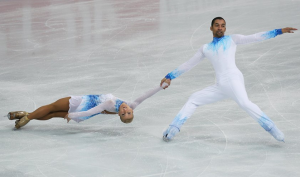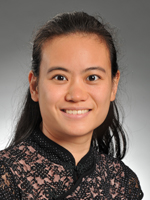Anyone who’s been watching the Winter Olympics has probably seen at least one figure skating event. But did they think about math while they watched?
Diana Cheng, an assistant professor of mathematics at Towson University, never stops. In fact, she uses figure skating to teach math to students from middle school through graduate level courses.
“I first thought about it when I was a high school teacher teaching algebra,” she says. “The textbook that I was using did not have many real-world examples to make learning algebra interesting and relevant to students’ lives.”
Cheng, who herself is a figure skater, was also in graduate school at the time, and had to create an activity that covered a difficult topic in an interesting way. And so her use of figure skating to teach mathematical concepts was born.
“Figure skating is a great model for mathematical instruction,” she says. “My graduate students and undergraduate students have enjoyed hearing how I have thought of my hobby as a mathematical endeavor, and some of them have been inspired to look at their hobbies mathematically.”
Those hobbies, she says, have included rock music, movies and other sports.
Cheng says figure skating’s International Judging System offers students less abstract ways to learn about data analysis, decimal operations and proportion reasoning—the ability to compare two things using multiplicative thinking. Pairs skating works for physics lessons because it allows students to analyze linear and angular momentum; what happens when the smaller female partner’s momentum joins with the male partner’s momentum? And how can one calculate the distance, rate, or time traveled across the ice when a pair is in the midst of the “death spiral”?

Skaters Aliona Savchenko and Robin Szolkowy perform a death spiral.
Photo: Getty Images
ISU GP of Figure Skating: Rostelecom Cup
And Cheng can show her work. She tells the story of the intercollegiate team she was on while studying for her doctorate. In 2008, using no particular mathematical strategy, the team placed sixth out of nine in a national competition. The following year, Cheng worked with her team’s coach to analyze her teammates’ strengths and then map out a strategy to match those strengths with the greatest scoring advantages. In 2009’s competition, she and her team bumped the ten-year champions out of the top spot and claimed the title.
Cheng says optimization was also the key to her win at the 2013 Eastern Sectional Championship Adult Gold Ladies event: “Given the jumps and spins that I can do, how can I arrange them in a program so that I earn my maximum technical element score?” And deciding whether to put an element in a skating program is basically a matter of the laws of probability: “Given that my success rate of completing this element is x percent, is it worth it to try it in the program?”
Since skaters can earn more points for executing a simpler element than they would for botching a more complicated one, it’s mathematical strategy that determines whether they change their program. Cheng’s Olympic example: American competitor Jeremy Abbott fell trying to do a quadruple toe loop in his short program. For the next day’s free skate event, his coaches swapped out the quadruple for a triple to maximize his points. That kind of strategy bears even more importance when skaters are competing in individual events to contribute to a team score, which happened for the first time ever this year.
But all of this is more than just an exercise in understanding mathematical principles; it’s a lesson in how much math is all around us, all the time. “Everything you’re doing in life can be viewed from a mathematical perspective,” says Cheng.
And yes, Cheng has been watching the Olympic skating competitions—particularly ice dancing. She likes the variety in the choreography, and her favorite pair, Americans Charlie White and Meryl Davis, won the gold last Monday. “They approach their skating as something they study,” she says, “and they are always trying to improve themselves… even though they are at the top.”
No American couple had ever won ice dancing gold. White and Davis strategized, played the odds, and set records at the same time.
There’s that math in everyday life again.

